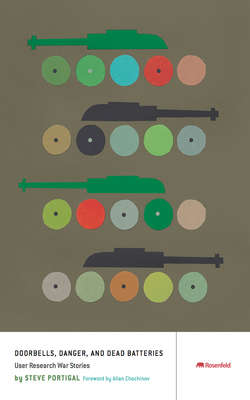Читать книгу Doorbells, Danger, and Dead Batteries - Steve Portigal - Страница 17
На сайте Литреса книга снята с продажи.
George Ressler: Skyfall (or a View to a Kill)
ОглавлениеRecently, I was on a project that focused on observing customer shopping behaviors at a retail space in Philadelphia. This was not the typical shop-along project because I was asked to observe customers without altering or impacting their shopping behavior. I believe that customers are aware of our presence as researchers, and it alters their shopping behavior, creating noise in the data. So, for this project, the research team really needed to become an invisible fly on the wall. To do this, we built a rig that consisted of several cameras that pushed a video feed to our research station in the back of the store. At our research station, we tracked the customer’s path and tagged shopping events as they happened. In simple terms, we created a high-tech mobile solution for capturing a customer’s journey that resembled something you might see James Bond using.
When the time came for the first of many fielding trips, we packed all the technology into three custom, black, hard shell cases that collectively weighed 228 pounds. We arrived at the Columbus airport extra early because we anticipated a lot of hassle from TSA for trying to fly with such “unique” equipment. At the ticket desk, our luggage was immediately flagged, and a TSA agent asked me to follow him into a back room to hand-inspect every item in the cases. As I watched from behind a yellow line of the floor, the agent tore apart my neatly packed electronics, swabbing everything for traces of explosives. All the while, he asked detailed questions about everything: “What is this? What does it do? Why do you have this?” After at least thirty minutes of explaining everything to this agent, he said that it all checked out, and I could re-pack the cases and head to the departure gate. When we arrived that afternoon in Philly, we were relieved to see our three cases thump down the baggage carousel. From the airport, we headed directly to the store to begin our setup process. Upon arriving at the store, we encountered our first real problem. Each store was supposed to have a 24-foot ladder, which would allow us to reach the ceiling to install our cameras; however, this store only had an 18-foot ladder. Being the most agile of the research team, I volunteered to climb on shelves, support beams, anything to get me up into the ceiling to install our cameras. At one point, I climbed a store shelf, holding on for dear life while clutching a 25-pound camera unit, thinking to myself that I would be so mad at myself if I died by falling off the shelf.
PHOTOS COURTESY OF LEXTANT
Once all the cameras were installed throughout the store, I began to set up the network that would pull all the video to our research station in the back room. Then problem number two arose: everything was set up perfectly, but I could not connect to the cameras from our research station. After an hour of troubleshooting, I finally realized that because our research station was behind a cement wall, the wireless signal was not reaching the cameras out in the store. In all my preparations for this trip, I had never thought to account for being behind a cement wall! The only solution was to move our router onto the store floor in front of the wall and then run an Ethernet cable to our back room research station. This meant I again climbed up to the ceiling and suspended the cable from the middle of the store to the back room. After almost an hour of monkey-climbing around the store, we had our cameras connected to the network and were ready to start collecting data.
The following two days were packed full of documenting customers’ journeys. It was fascinating to observe customers shopping while slowly seeing patterns in behavior emerge. After our time in the store collecting data was over, I repeated my climb up the shelves to the ceiling to retrieve our cameras and packed up our three black cases.
We made it through TSA at the Philly airport much smoother than in Columbus and got to the gate early, leaving ample time to relax. After landing in Columbus, we waited at the baggage claim for our cases and in no time the first case clunked down the carousel. However, the other two cases never appeared. We checked their status at the baggage claim office where they informed us that our other two cases were held back for further screening because they contained “suspicious materials.” We assumed they would eventually be cleared and indeed they arrived in Columbus on the next flight from Philly.
Before this all gets blamed on the TSA, those two cases did look very suspicious. I was amazed that we got them to Philly with so few problems. Each one of those cases contained a couple of huge batteries, lots of wires, and electrical boxes. Without a close inspection, the cases did look like very large, heavy bombs. So as much as I was upset at TSA for holding our cases back, I was relieved to know that they were actually catching bomb-like packages at airports and taking the time to inspect them properly.
Whenever I tell this story, I will always remember the problems we overcame with transporting and installing the technology. I can still picture myself jumping from store shelf to store shelf trying to reach the ceiling to install the cameras. But above all, I vividly remember how much I felt like James Bond when we arrived at the store with three heavy cases full of complex “spy” technology. Next time we do this kind of project, I will be bringing my tuxedo, so I could really bring the Bond persona to life.
